2016 U.S. Soy Global Trade Exchange Offers Wide Variety of Speakers
- Category:
- General News

The 2016 U.S. Soy Global Trade Exchange presented a varied assortment of speakers, tailored to suit all conference participants.
Prior to the official start of the conference, USSEC hosted a forum discussing sustainability along the soy value chain. USSEC consultant Paul Smolen spoke about how sustainability involves a triple bottom line: planet, people, and profit.
The first panel included representatives from Thompsons Feeding Innovation in Northern Ireland, Wei Chuan Foods Corporation in Thailand, and Solla of Medellin, Colombia, who spoke about their companies’ corporate social responsibility policies and provided perspective from international customer on what sustainability means to their businesses.
George Starrett of Thompsons Feeding Innovation discussed the sustainability of his operation, citing that the dairy sector has reduced CO2 emissions per kilogram of milk produced by 28 percent since 1990, and along with a 50 percent reduction in fertilizer usage in the last 20 years. Solla’s Juan Guillermo Jaramillo stated that his company’s corporate social responsibility policy helps “to contribute to human welfare through animal nutrition.”
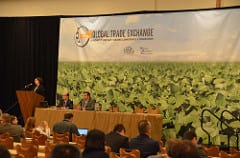
The second panel provided a U.S. industry perspective on sustainability. USSEC vice chairman and United Soybean Board (USB) director Derek Haigwood spoke about his family farm in Arkansas. “When you talk about sustainability, the first thing that comes to my mind is biotech,” he stated.
Mr. Haigwood, who farms with his father and brothers, said that 55 percent of farmers have increased their yields on roughly the same amount of land by using conservation practices and that U.S. farmers are focused on continuous improvement. Some of the sustainability measures that the Haigwoods employ include precision farming, no-till, innovative irrigation, cover crops, and conservation and wetlands.
USSEC Marketing Director – Market Access Roz Leeck talked about how the soy value chain can pull sustainability efforts together, discussing the U.S. Soybean Sustainability Assurance Protocol (SSAP) and its four primary directives; how U.S. cropland has decreased while forestland has increased; and U.S. Soy Export Sustainability (USSES) certificate issuance.
Megan Weidner of Bunge North America spoke about sustainability, traceability, and transparency.
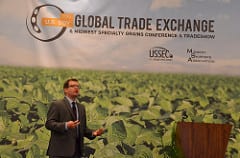
Dr. Seth Meyer, Chairman of the World Agriculture Outlook Board – U.S. Department of Agriculture (USDA) Office of the Chief Economist, opened the conference with a global soy and grain supply and demand outlook. Dr. Meyer projected that global trade growth is expected to continue, and stated that for China, soybean imports are key to meal consumption growth. China currently accounts for almost two-thirds of the world’s soybean trade.
Pauline Oudin of Soprexa presented the results of the company’s 2015 multi-country “foodie” study that looked at the preferences and behaviors of millennials and younger food consumers in China, Japan and the U.S., among other countries.
A transportation panel discussion featured Great Lakes grain and soy shipping. Adam Schlicht of the U.S. Department of Transportation St. Lawrence Seaway Development Corporation; David Gutheil of Antwerp Express; Kate Ferguson of Duluth Seaway Port Authority; and Zach Mandel of Nidera-USA Chicago Illinois River Marketing, Inc. took part in this breakout session.
Another feed-focused session featured Dr. Gonzalo G. Mateos, professor of animal science at the University of Madrid, Spain. During the session, “All Soybeans are Not Created Equal – Comparative Analysis of the Nutritional Value of Soybeans from Different Countries,” Dr. Mateos discussed his research on the nutritive value and energy quality of soybean meal for pigs and poultry. He said that soybean meal is the world’s top and most convenient of the world’s protein meals’ supply. Various countries’ soybean meal supplies different qualities. For example, Brazil’s soy provides more protein and U.S. Soy provides more fiber.
“To me, the protein is not important,” he declared, explaining that crude protein is not the best indicator of nutrition. “I care about the composition and the quality of the protein.”
The following feed session, “Do Pigs Care Where Their Soy is Grown? Should You?” was a case study on the effects of origin of soybean meal on the digestibility of amino acids presented by Dr. Hans H. Stein, professor of animal nutrition at the University of Illinois. Dr. Stein concluded his study in July 2016 and discussed his methodology and results. Dr. Stein’s team analyzed digestible, metabolizable energy by analyzing the feces and urine of pigs. “The most expensive part of the diet is the energy,” he stated.
Dr. Stein revealed that his study showed that U.S. soybean meal had more digestible amino acids than that of other origins, and that soybean meal from the U.S. has greater digestibility and less variability in composition and digestibility.
A food session discussed the U.S. food grade soybean outlook for 2016-2017, led by a panel of specialty food bean supplier and exporters, including Ray Loucks of IOM Grain; USSEC treasurer Jim Traub of Clarkson Grain; Steve Ford of Stonebridge; USSEC director Aaron Skyberg of SK Food Intl; and Midwest Shippers Association chairman Roger Mortensen of Grain Millers.
The transportation breakout session focused on bulk soy and grain freight trends and how the inland river barge and gulf export ship-loading facilities help the U.S. to maintain a competitive edge. The panel included Patrick Ries of CBG Enterprises, Inc. and Mike Steenhoek of the Soy Transportation Coalition.
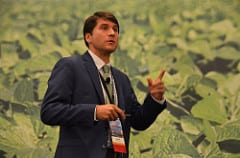
The final presentation of the day was a plenary session, “Global Weather Outlook for Agriculture 2016-2017,” given by Dr. Daniel Redo, manager of agricultural research for Thomsen Reuters Lanworth. Dr. Redo said that in 50 years, soybean production has increased tenfold, with production actually outpacing demand. Adverse weather is usually the catalyst of price shifts, he explained, with the last major price increase taking place in 2012 and he did not forecast the high production schedule to end anytime soon.
The second day of the conference began with several breakout sessions.
Arlan Suderman, chief commodities economist at International FCStone Financial, Inc. provided an outlook for trends driving global livestock demand. Mr. Suderman looked at various countries that show consumption trends of meat including beef, pork, and poultry, taking into account meat production needs and protein consumption and the need to produce that protein.
He explained, “as income rises, beef consumption declines, but not in South America or Asia.” In Asia, as income rises, there’s an increase in pork consumption, but in the U.S., pork consumption is trending lower. Poultry consumption, however, is continuing to rise in most countries regardless of income.
While aging affects consumption patterns overall, income affects choice. Income will continue to be a driver in meat consumption.
Increased soybean meal supplies are near-term dependent on the U.S. for expansion.

Neil Doty of Northern Crops Institute, Bruce Roskens of Grain Millers, Inc., and Chris Crawford of Scoular served on a panel discussion of specialty grains, “Rising Global Market Demand and North American Production of Specialty Grains – Pulses, Oats, Flax, Non-GMO and Food Grain Corn and More.”
The transportation session included an update on developments for export container shopping/inland intermodal rail service from Dan Bresolin of the Canadian National Railroad and Eric Powell of Indiana Railroad Co.
A presentation on international trade focused on providing a global view of key dynamics in policy and commerce for grains, oilseeds, and other agri-bulks. Gary Martin, president of the North American Export Grain Association was the speaker.
Sebastian Belle, executive director of the Maine Aquaculture Association, presented, “Global Aquaculture Situation and Future Opportunities – Soy in Aquaculture: Farming the Land to Sustain the Sea.”
Mr. Belle said that by 2020, 50 percent of the world’s population will have the same standard of living as the U.S. and world protein demand will be up 60 percent. The World Bank forecasts that the demand for aquaculture will see a 90 percent increase by 2050, although private estimates are as high as a 277 percent increase. Currently, aquaculture feed is four percent of the world feed market with China the number one aquafeed producer. As fishmeal and fish oil continue to become more expensive, more and more aquafeed producers will look to alternative feed ingredients such as soy.
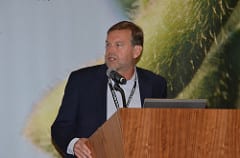
Mr. Belle explained that critical issues for any feed ingredient from farmers’ perspectives are: availability; nutritional profile; palatability – fish do not naturally eat carbohydrates; digestibility; cost; final product quality; and environmental impacts of ingredient during production.
He sees the two biggest challenges from the production side as disease and access to cost-effective feeds. “If we don’t solve that problem [of cost effective feeds], we will not see the growth that we hope to see in aquaculture.”
Tim Quinlan, senior economist at Wells Fargo Securities, gave the closing keynote address. Mr. Quinlan discussed the Federal Reserve and interest rates, the outlook for the U.S. economy, and how that fits into the broader context of global economic growth.
“If I was to describe 2016 in a nutshell right now, we have more or less had pretty strong labor market dynamics and pretty weak output sectors,” he stated.
Mr. Quinlan said that it would take a sharp downturn in the rest of the world to have a meaningful effect on U.S. economic growth and concluded, “We forecast that global GDP growth will remain below its long-run average in 2016.”
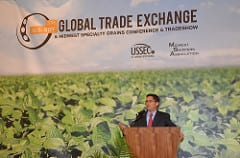
Presentations are now available at https://www.grainconference.org/ - !2016-conference/kawgn.